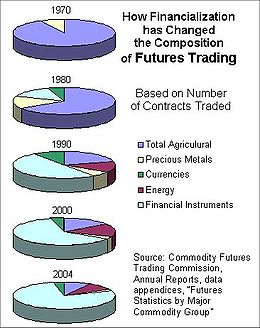Futures contract
For example, in gold futures trading, the margin varies between 2% and 20% depending on the volatility of the spot market.In this vein, the futures exchange requires both parties to put up initial cash, or a performance bond, known as the margin.On the delivery date, the amount exchanged is not the specified price on the contract but the spot value, since any gain or loss has already been previously settled by marking to market.To minimize counterparty risk to traders, trades executed on regulated futures exchanges are guaranteed by a clearing house.Margin requirements are waived or reduced in some cases for hedgers who have physical ownership of the covered commodity or spread traders who have offsetting contracts balancing the position.Clearing margin are financial safeguards to ensure that companies or corporations perform on their customers' open futures and options contracts.If a position involves an exchange-traded product, the amount or percentage of the initial margin is set by the exchange concerned.Margin-equity ratio is a term used by speculators, representing the amount of their trading capital that is being held as margin at any particular time.On the expiry date, a European equity arbitrage trading desk in London or Frankfurt will see positions expire in as many as eight major markets almost every half an hour.Exchanges implement strict limits on how much exposure an entity may have closer to expiration as an effort to avoid any volatility around final settlement.When the deliverable asset exists in plentiful supply or may be freely created, then the price of a futures contract is determined via arbitrage arguments.Arbitrage arguments ("rational pricing") apply when the deliverable asset exists in plentiful supply or may be freely created.Thus, assuming constant rates, for a simple, non-dividend paying asset, the value of the futures/forward price, F(t,T), will be found by compounding the present value S(t) at time t to maturity T by the rate of risk-free return r. or, with continuous compounding This relationship may be modified for storage costs u, dividend or income yields q, and convenience yields y.[13] Dividend or income yields q are more easily observed or estimated, and can be incorporated in the same way:[14] In a perfect market, the relationship between futures and spot prices depends only on the above variables; in practice, there are various market imperfections (transaction costs, differential borrowing, and lending rates, restrictions on short selling) that prevent complete arbitrage.When the deliverable commodity is not in plentiful supply (or when it does not yet exist) rational pricing cannot be applied, as the arbitrage mechanism is not applicable.The expectation-based relationship will also hold in a no-arbitrage setting when we take expectations with respect to the risk-neutral probability.Although contract trading began with traditional commodities such as grains, meat, and livestock, exchange trading has expanded to include metals, energy, currency and currency indexes, equities and equity indexes, government interest rates, and private interest rates.For example, in traditional commodity markets, farmers often sell futures contracts for the crops and livestock they produce to guarantee a certain price, making it easier for them to plan.Investment fund managers at the portfolio and the fund sponsor level can use financial asset futures to manage portfolio interest rate risk, or duration, without making cash purchases or sales using bond futures.With many investors pouring into the futures markets in recent years controversy has risen about whether speculators are responsible for increased volatility in commodities like oil, and experts are divided on the matter.This gains the portfolio exposure to the index which is consistent with the fund or account investment objective without having to buy an appropriate proportion of each of the individual 500 stocks just yet.This also preserves balanced diversification, maintains a higher degree of the percent of assets invested in the market and helps reduce tracking error in the performance of the fund/account.Calls and options on futures may be priced similarly to those on traded assets by using an extension of the Black-Scholes formula, namely the Black model.Examples are options on futures with the underlying in gold (XAU), index (Nasdaq, S&P 500) or commodities (oil, VIX).The stock exchanges and their clearing houses provide overviews of these products (CME,[23] COMEX, NYMEX).In a forward though, the spread in exchange rates is not trued up regularly but, rather, it builds up as unrealized gain (loss) depending on which side of the trade being discussed.The margining of futures eliminates much of this credit risk by forcing the holders to update daily to the price of an equivalent forward purchased that day.This means that the "mark-to-market" calculation would require the holder of one side of the futures to pay $2 on day 51 to track the changes of the forward price ("post $2 of margin").A forward-holder, however, may pay nothing until settlement on the final day, potentially building up a large balance; this may be reflected in the mark by an allowance for credit risk.
FinanceMarketsAssetsAsset (economics)Asset growthCapital assetCommodityDerivativesDomainsEquityForeign exchangeOver-the-counterPrivate equityReal estateParticipantsAngel investorBull (stock market speculator)Financial plannerInvestorinstitutionalRetailSpeculatorLocationsFinancial centresOffshore financial centresConduit and sink OFCsInstrumentsCollateralised debt obligationCredit default swapTime depositcertificate of depositCredit lineDepositDerivativeIndemnityInsuranceLetter of creditMortgageOptionexoticPerformance bondsRepurchase agreementSecuritySyndicated loanSynthetic CDOCorporateAccountingCapital budgetingCapital structureCorporate financeCredit rating agencyEnterprise risk managementEnterprise valueRisk managementFinancial statementsLeveraged buyoutMergers and acquisitionsStructured financeVenture capitalTaxationBase erosion and profit shiftingCorporate tax havenTax inversionTax havenTransfer pricingPersonalCreditEmployment contractFinancial planningRetirementStudent loanPublicGovernment spendingFinal consumption expenditureOperationsRedistributionTransfer paymentGovernment revenueDeficit spendingBudgetbalanceNon-tax revenueWarrant of paymentBankingCentral bankDeposit accountFractional-reserveFull-reserveInvestment bankingMoney supplyLists of banksBank regulationBanking licenseBasel AccordsBank for International SettlementsFinancial Stability BoardDeposit insuranceSeparation of investment and retail bankingRegulationFinancial lawInternational Financial Reporting StandardsISO 31000Professional certificationFund governanceEconomic historyPrivate equity and venture capitalRecessionStock market bubbleStock market crashAccounting scandalsOutlinefinancial instrumentfutures exchangesvolatilityspot marketstock futurestock market indexcurrency futuresinterest rate futuresstock market index futuresperpetual futuresorgan futuresspeculationDōjima Rice Exchangefutures exchangesamurai